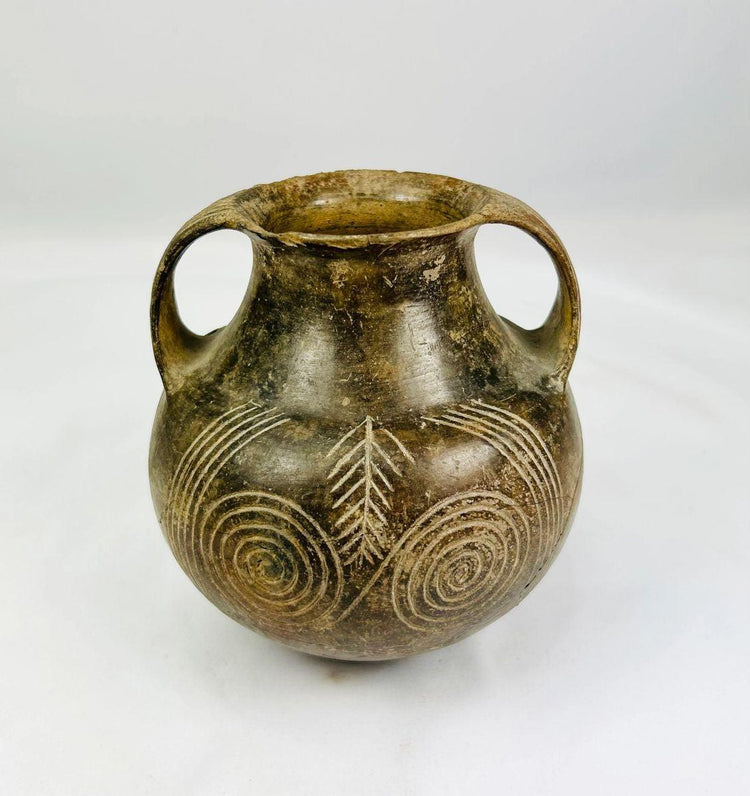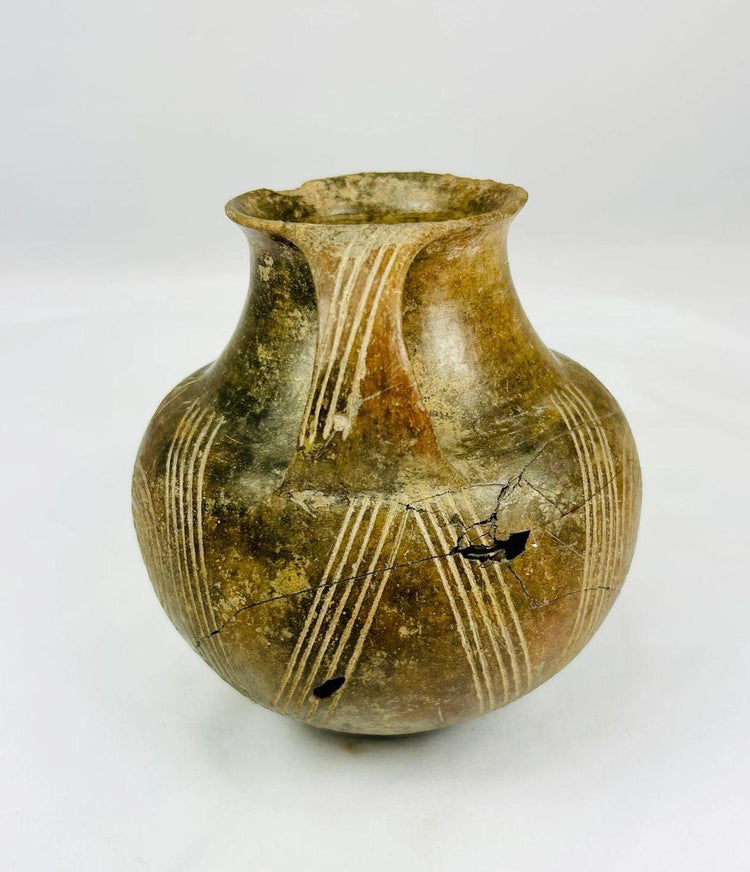Neolithic–Early Bronze Age Pottery Jug | Double-Handled Ritual Vessel | Central or Eastern Europe | Circa 3000–2000 BCE
Description
More
Less
Historical Context & Origin
Region: Central or Eastern Europe
Material: Terracotta (handmade pottery)
Period: Neolithic to Early Bronze Age, circa 3000–2000 BCE
Description
This ancient pottery jug is a rare and fascinating example of early European craftsmanship during the transition from nomadic to agricultural societies. Hand-built and decorated with incised linear and circular patterns, the jug embodies both functional design and symbolic artistry. Its double-handled form suggests that it may have been used in ritual contexts, for libations or offerings, in addition to daily storage of precious liquids such as oils, mead, or water.
Features
- Incised geometric motifs including linear and concentric circle designs
- Double-handled construction, likely for ceremonial use
- Compact body with wide rim, functional for both storage and ritual pouring
- Natural wear and surface patina developed over millennia
Cultural Significance
Vessels of this kind were not only utilitarian but also carried strong symbolic meaning. The geometric patterns may have represented fertility, spirituality, or cosmological beliefs central to Neolithic and Bronze Age cultures. The presence of dual handles is often associated with ritual offerings or ceremonial practices, emphasizing the jug’s likely spiritual as well as practical role.
Condition
Good ancient condition with visible surface wear, cracks, and minor losses consistent with age. The jug remains structurally sound, and the patina highlights its authenticity and archaeological significance.
Dimensions (approximate)
Height: 5.5 in
Width: 5.5 in
Age
Neolithic to Early Bronze Age, circa 3000–2000 BCE
Learn More & Explore
See Related Artifacts in Our Collection: Ancient Jugs and Ritual Vessels
Explore a Similar Artifact at The Metropolitan Museum of Art: Early Bronze Age Jug, ca. 3000–2000 BCE
Description
Historical Context & Origin
Region: Central or Eastern Europe
Material: Terracotta (handmade pottery)
Period: Neolithic to Early Bronze Age, circa 3000–2000 BCE
Description
This ancient pottery jug is a rare and fascinating example of early European craftsmanship during the transition from nomadic to agricultural societies. Hand-built and decorated with incised linear and circular patterns, the jug embodies both functional design and symbolic artistry. Its double-handled form suggests that it may have been used in ritual contexts, for libations or offerings, in addition to daily storage of precious liquids such as oils, mead, or water.
Features
- Incised geometric motifs including linear and concentric circle designs
- Double-handled construction, likely for ceremonial use
- Compact body with wide rim, functional for both storage and ritual pouring
- Natural wear and surface patina developed over millennia
Cultural Significance
Vessels of this kind were not only utilitarian but also carried strong symbolic meaning. The geometric patterns may have represented fertility, spirituality, or cosmological beliefs central to Neolithic and Bronze Age cultures. The presence of dual handles is often associated with ritual offerings or ceremonial practices, emphasizing the jug’s likely spiritual as well as practical role.
Condition
Good ancient condition with visible surface wear, cracks, and minor losses consistent with age. The jug remains structurally sound, and the patina highlights its authenticity and archaeological significance.
Dimensions (approximate)
Height: 5.5 in
Width: 5.5 in
Age
Neolithic to Early Bronze Age, circa 3000–2000 BCE
Learn More & Explore
See Related Artifacts in Our Collection: Ancient Jugs and Ritual Vessels
Explore a Similar Artifact at The Metropolitan Museum of Art: Early Bronze Age Jug, ca. 3000–2000 BCE
You May Also Like




















